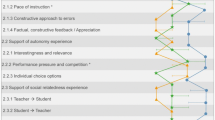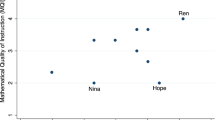Abstract
The notion of quality in undergraduate mathematics lectures is examined by using theoretical notions and research results from the literature and empirical data from a case study on lecturing on limits of functions. A systemic triangular model is found to catch critical quality aspects of a mathematics lecture, consisting of mathematical exposition, teacher immediacy, and general quality criteria for mathematics teaching. Mathematical exposition involves the dynamic interplay of mathematical content, mathematical process, and institutionalisation. The discussion is a contribution to an increased pedagogical awareness in undergraduate mathematics teaching.
Similar content being viewed by others
References
Alsina, C. (2001). Why the professor must be a stimulating teacher. In D. Holton (Ed.),The teaching and learning of mathematics at university level: an ICMI Study (pp. 3–12). Dordrecht, The Netherlands: Kluwer.
Anthony, G. (1997). Students’ and lecturers’ perceptions of factors influencing students’ success in first-year undergraduate mathematics courses. In F. Biddulph & K. Carr (Eds.),People in mathematics education (Proceedings of the 20th annual conference of the Mathematics Education Research Group of Australasia, pp. 58–64). Rotoura, NZ: MERGA.
Anthony, G., Hubbard, R., & Swedosh, P. (2000). Undergraduate mathematics teaching and learning. In K. Owens & J. Mousley (Eds.),Mathematics education research in Australasia 1996–1999 (pp. 243–269). Melbourne: MERGA.
Barbé, J., Bosch, M., Espinoza, L., & Gascon, J. (2005). Didactic restrictions on the teacher’s practice: the case of limits of functions in Spanish high schools.Educational Studies in Mathematics, 59(2–3), 235–268.
Barnard, T., & Morgan, C. (1996). Theory and practice in undergraduate mathematics teaching: A case study. In L. Puig & A. Gutiérrez (Eds.),Proceedings of 20th conference of the International Group for the Psychology of Mathematics Education (Vol. 2, pp. 43–50). València, Spain: PME.
Biggs, J. (2003).Teaching for quality learning at university (2nd ed.). Maidenhead, Berkshire, UK: Open University Press.
Bligh, D. (1972).What’s the use of lectures? Harmondsworth, Middlesex, UK: Penguin.
Blum, W. (2004).Opportunities and problems for “Quality Mathematics Teaching” — the SINUS and DISUM projects. Paper presented as a regular lecture at ICME 10, Copenhagen 2004.
Bradley, K., Sampson, S., & Royal, K. (2006). Applying the Rasch rating scale model to gain insights into students’ conceptualisation of quality mathematics instruction.Mathematics Education Research Journal, 18(2), 11–26.
Forgasz, H. & Swedosh, P. (1997). The University of Melbourne’s mathematics students: Who are they? Why are they? Will they stay? In F. Biddulph & K. Carr (Eds.),People in mathematics education (Proceedings of the 20th annual conference of the Mathematics Education Research Group of Australasia, pp. 170–176). Rotoura, NZ: MERGA.
Fritze, Y., & Nordkvelle, Y.T. (2003). Comparing lectures: effects of the technological context of a studio.Education and Information Technologies, 8(4), 327–343.
Frymier, A. B. (1994). Amodel of immediacy in the classroom.Communication Quarterly, 42 (2), 133–144.
Harel, G., & Trgalova, J. (1996). Higher mathematics education. In A. Bishop et al. (Eds.),International handbook of mathematics education (pp. 675–700). Dordrecht, The Netherlands: Kluwer.
Holton, D. (Ed.). (2001).The teaching and learning of mathematics at university level: an ICMI Study, (New ICMI Study Series Vol. 7). Dordrecht, The Netherlands: Kluwer.
Hubbard, R. (1997).Why do students attend lectures and what do they learn? Paper presented at the Delta’97 Symposium on Undergraduate Mathematics, Brisbane.
Kilpatrick, J., Swafford, J., & Findell, B. (Eds.). (2001).Adding it up. Helping children to learn mathematics. Washington, DC: National Academy Press.
Krantz, S. (1999).How to teach mathematics. Providence, RI: American Mathematical Society.
Lakoff, G., & Núñez, R. (2000).Where mathematics comes from. New York: Basic Books.
Leron, U., & Dubinsky, E. (1995). An abstract algebra story.American Mathematical Monthly, 102(3), 227–242.
Lester, F. (2005). On the theoretical, conceptual, and philosophical foundations for research in mathematics education.Zentralblatt für Didaktik der Mathematik, 37(6), 457–467.
Lewis, L., Parsad, B., Carey, N., Bartfai, N., Farris, E, & Smerdon, B. (1999).Teacher quality: A report on the preparation and qualifications of public school teachers. Washington, DC: National Centre for Educational Statistics.
Nardi, E., Jaworski, B., & Hegedus, S. (2005). A spectrum of pedagogical awareness for undergraduate mathematics: From “tricks” to “techniques”.Journal for Research in Mathematics Education, 36(4), 284–316.
Niss, M. (2004). The Danish “KOM” project and possible consequences for teacher education. In R. Strässer, G. Brandell, B. Grevholm, & O. Helenius (Eds.),Educating for the future. Proceedings of an international symposium on mathematics teacher education. Göteborg, Sweden: The Royal Swedish Academy of Science.
Przenioslo, M. (2004). Images of the limit of function formed in the course of mathematical studies at the university.Educational Studies in Mathematics, 55(1–3), 103–132.
Radford, L. (2003). Gestures, speech, and sprouting of signs: Asemiotic-cultural approach to students’ types of generalization.Mathematical Thinking and Learning, 5(1), 37–70.
Rodd, M. (2003). Witness as participation: the lecture theatre as a site for mathematical awe and wonder.For the Learning of Mathematics, 23(1), 15–21.
Saroyan, A., & Snell, L.S. (1997). Variations in lecturing styles.Higher Education, 33, 85–104.
Weber, K. (2004). Traditional instruction in advanced mathematics courses: a case study of one professor’s lectures and proofs in an introductory real analysis course.Journal of Mathematical Behavior, 23(2), 115–133.
Wood, L., & Smith, G. (2004).Language of university mathematics. Paper presented at Topic Study Group 25 (Language and communication in mathematics education) at ICME10, Copenhagen 2004. Retrieved July 25, 2006 from http://www.icme10.dk
Yackel, E., & Cobb, P. (1996). Sociomathematical norms, argumentation and autonomy in mathematics.Journal for Research in Mathematics Education, 27(4), 458–477.
Author information
Authors and Affiliations
Rights and permissions
About this article
Cite this article
Bergsten, C. Investigating quality of undergraduate mathematics lectures. Math Ed Res J 19, 48–72 (2007). https://doi.org/10.1007/BF03217462
Issue Date:
DOI: https://doi.org/10.1007/BF03217462




